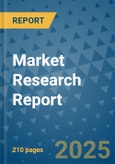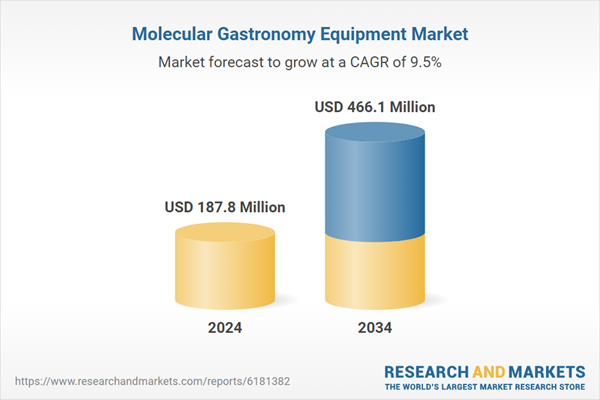The growth is driven by the rising demand for innovative dining experiences, the increasing incorporation of advanced culinary techniques in professional kitchens, and growing investment in culinary arts education. The adoption of precision cooking technologies like sous vide, cryogenic processing, and vacuum-based systems is reshaping modern gastronomy. Chefs and culinary institutions are embracing these tools to redefine food textures, presentation, and flavor profiles, reflecting a clear departure from conventional cooking. The rise in popularity of immersive, experience-led dining is contributing to equipment sales, as high-end restaurants strive to stand out in a competitive industry. Moreover, consumer interest in novel, Instagram-worthy food creations has prompted chefs to invest in next-gen tools that bring science into the kitchen. The growing availability of smart kitchen systems and IoT-enabled cooking solutions is expected to push innovation forward, as restaurants aim to enhance both back-of-house operations and customer satisfaction. The industry’s expansion aligns closely with the evolution of food as both a science and a luxury art form.
The professional kitchen segment held a 45% share in 2024 and is expected to reach USD 209.5 million by 2034. This segment is seeing robust growth as upscale restaurants increasingly adopt equipment to deliver visually stunning and technically precise dishes that resonate with social media trends. These culinary spaces are investing heavily in advanced cooking systems to improve consistency, creativity, and guest experience. Social media’s influence, combined with the appeal of renowned chefs showcasing molecular gastronomy, is driving restaurants to differentiate with cutting-edge culinary tools. This trend is helping redefine how modern fine dining establishments compete in saturated markets, positioning innovation at the core of their brand appeal.
The sous vide systems segment generated USD 32.7 million in 2024 and is estimated to reach USD 81.2 million by 2034. Their increasing integration into professional kitchens highlights their versatility, precision, and performance consistency. While initially associated with experimental cooking, sous vide equipment has become standard in premium restaurants due to its ability to precisely control temperature and deliver enhanced texture, taste, and presentation. This widespread adoption signals its transition from niche use to mainstream culinary application, making it an essential asset in contemporary kitchen operations.
U.S. Molecular Gastronomy Equipment Market accounted for USD 59.2 million in 2024 and is anticipated to reach USD 146.8 million by 2034. Market growth in the country is largely attributed to the expansion of culinary technology, the presence of world-renowned culinary schools, and a consumer base eager for elevated and unique dining experiences. States like California, Illinois, and New York are witnessing particularly strong uptake, with top-tier restaurants leveraging molecular gastronomy equipment to set new standards in precision cooking and artistic food plating, appealing to both connoisseurs and culinary influencers.
Key companies leading in the Global Molecular Gastronomy Equipment Market include The Kitchen Lab, METTLER TOLEDO International Inc., Praxair, and MSK Ingredients. Companies competing in the Molecular Gastronomy Equipment Market are implementing innovative-centric strategies to capture growing demand in high-end culinary spaces. Many are investing in R&D to introduce multifunctional, IoT-enabled tools that cater to chefs' evolving needs for precision and creativity. Expanding global distribution networks, especially in North America and Europe, is another top priority to enhance reach. Partnerships with culinary schools and professional chef organizations help firms build brand loyalty early among future adopters. Customized equipment offerings tailored for restaurant scale and training environments also support competitive positioning.
Comprehensive Market Analysis and Forecast
- Industry trends, key growth drivers, challenges, future opportunities, and regulatory landscape
- Competitive landscape with Porter’s Five Forces and PESTEL analysis
- Market size, segmentation, and regional forecasts
- In-depth company profiles, business strategies, financial insights, and SWOT analysis
This product will be delivered within 2-4 business days.
Table of Contents
Companies Mentioned
The companies profiled in this Molecular Gastronomy Equipment market report include:- METTLER TOLEDO International
- Praxair
- The kitchen Lab
- MSK Ingredients
- Vollrath Company
- Anova Culinary
- VacMaster
- OHAUS Corporation
- Terra Universal
Table Information
| Report Attribute | Details |
|---|---|
| No. of Pages | 210 |
| Published | October 2025 |
| Forecast Period | 2024 - 2034 |
| Estimated Market Value ( USD | $ 187.8 Million |
| Forecasted Market Value ( USD | $ 466.1 Million |
| Compound Annual Growth Rate | 9.5% |
| Regions Covered | Global |
| No. of Companies Mentioned | 10 |









